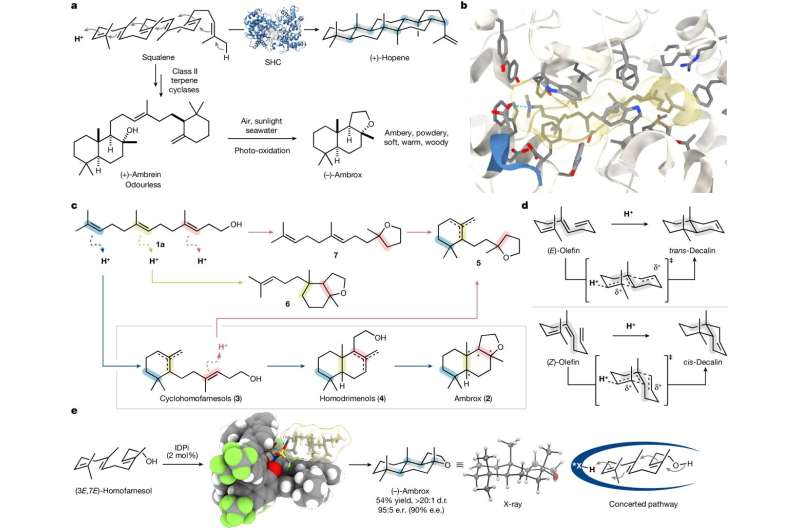This article has been reviewed according to Science X's editorial process and policies. Editors have highlighted the following attributes while ensuring the content's credibility:
fact-checked
peer-reviewed publication
trusted source
proofread
Fine fragrances from test tubes: A new method to synthesize ambrox

Mankind has been craving pleasant smells and therefore working on perfumes since ancient times—fine scents have always been considered a source of inspiration, and a good fragrance has always been a sign of health. The scarce natural product (−)-ambrox, which is traditionally isolated from ambergris, a waxy substance from the digestive tract of sperm whales, has been one of the most popular fragrances in the world for a long time.
More than 30 tons are produced annually. Importantly, only one mirror image out of 16 possible variants of the chiral molecule delivers the particularly pleasant odor sensation, which necessitates a stereoselective synthesis that only produces the desired mirror image.
Fortunately, it is no longer necessary to gather it from whales, but it can be obtained via partial synthesis from (−)-sclareol, a natural product that occurs in large amounts in a certain type of sage. However, the plant-based process to obtain ambrox requires multiple steps and is dependent on the availability of clary sage, which is subject to fluctuations.
Now a research group led by Prof. Benjamin List, Director at the Max Planck Institut für Kohlenforschung, has succeeded in synthesizing the fragrant and highly complex chiral molecule in the laboratory. The researchers have published their results in the journal Nature in their article titled "The catalytic asymmetric polyene cyclization of homofarnesol to ambrox."
"In biology, polyene cyclizations are complex reactions that convert simple starting materials into complicated molecular structures—in just one step," explains Mathias Turberg, one of Prof. List's doctoral students and one of the lead authors of the study. "We were inspired by nature—we also wanted to provide a method for synthesizing complex molecules from rather simple starting materials."
His colleague, Dr. Na Luo, postdoctoral researcher in Prof. List's group and lead author of the paper, says, "Imitating nature in the laboratory is a major yet appealing challenge for chemists." Prof. List himself says that this reaction is "a provocation by nature to us chemists," as nature with its large enzymes can guide the polyene to fold itself so that it easily makes the desired isomer.
For the List group's method, the renewable C15 building block nerolidol, which occurs in many plant sources and can also be synthesized on a technical scale, forms the starting material. In a collaboration with the Chemical Company BASF, nerolidol is converted from a C15 into the C16 building block homofarnesol, which is then selectively converted to (−)-ambrox.
"With our strongly acidic and confined catalyst and a special, fluorinated solvent, we managed to selectively synthesize the desired natural product, one out of 16 possible isomers," says Luo. While the List group has expertise in this certain type of confined catalysts, Luo was responsible for sharpening the "molecular tool" for this specific reaction.
Whereas the catalyst pre-organizes the starting material and initiates the transformation into the product, the specific solvent stabilizes reactive intermediates and serves, among other things, as a "boost" to the catalysts and therefore makes things even faster. Quite successful: While the state-of-the-art biocatalytic reaction takes three to four days, the new method provides the product overnight.
"We managed to run our reaction under relatively mild conditions—and also in one single step. The outcome is highly selective," explains Luo.
"Key to the high selectivity of the process is the conversion of homofarnesol to (−)-ambrox in a concerted fashion, which mimics enzyme-catalyzed polyene cyclizations," adds Turberg.
The scientists could also demonstrate that their approach is readily scalable. Another advantage of the List group's synthesis is that catalyst and solvent can be recovered and reused for more reactions. Both aspects are promising for potential future industrial applications.
More information: Na Luo et al, The catalytic asymmetric polyene cyclization of homofarnesol to ambrox, Nature (2024). DOI: 10.1038/s41586-024-07757-7
Journal information: Nature
Provided by ITER




















